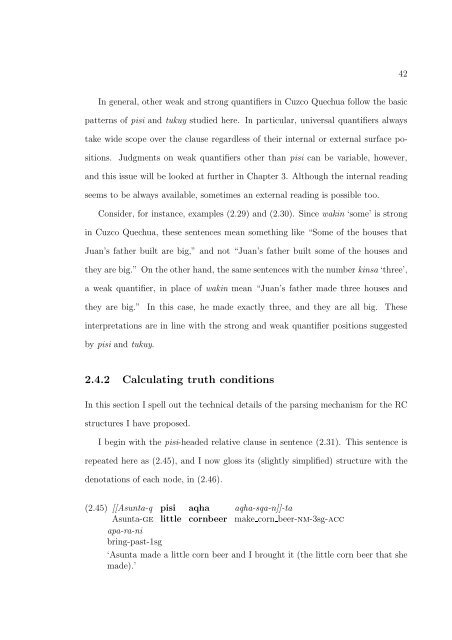the syntax and semantics of relativization and quantification
the syntax and semantics of relativization and quantification
the syntax and semantics of relativization and quantification
Create successful ePaper yourself
Turn your PDF publications into a flip-book with our unique Google optimized e-Paper software.
42<br />
In general, o<strong>the</strong>r weak <strong>and</strong> strong quantifiers in Cuzco Quechua follow <strong>the</strong> basic<br />
patterns <strong>of</strong> pisi <strong>and</strong> tukuy studied here. In particular, universal quantifiers always<br />
take wide scope over <strong>the</strong> clause regardless <strong>of</strong> <strong>the</strong>ir internal or external surface positions.<br />
Judgments on weak quantifiers o<strong>the</strong>r than pisi can be variable, however,<br />
<strong>and</strong> this issue will be looked at fur<strong>the</strong>r in Chapter 3. Although <strong>the</strong> internal reading<br />
seems to be always available, sometimes an external reading is possible too.<br />
Consider, for instance, examples (2.29) <strong>and</strong> (2.30). Since wakin ‘some’ is strong<br />
in Cuzco Quechua, <strong>the</strong>se sentences mean something like “Some <strong>of</strong> <strong>the</strong> houses that<br />
Juan’s fa<strong>the</strong>r built are big,” <strong>and</strong> not “Juan’s fa<strong>the</strong>r built some <strong>of</strong> <strong>the</strong> houses <strong>and</strong><br />
<strong>the</strong>y are big.” On <strong>the</strong> o<strong>the</strong>r h<strong>and</strong>, <strong>the</strong> same sentences with <strong>the</strong> number kinsa ‘three’,<br />
a weak quantifier, in place <strong>of</strong> wakin mean “Juan’s fa<strong>the</strong>r made three houses <strong>and</strong><br />
<strong>the</strong>y are big.” In this case, he made exactly three, <strong>and</strong> <strong>the</strong>y are all big. These<br />
interpretations are in line with <strong>the</strong> strong <strong>and</strong> weak quantifier positions suggested<br />
by pisi <strong>and</strong> tukuy.<br />
2.4.2 Calculating truth conditions<br />
In this section I spell out <strong>the</strong> technical details <strong>of</strong> <strong>the</strong> parsing mechanism for <strong>the</strong> RC<br />
structures I have proposed.<br />
I begin with <strong>the</strong> pisi-headed relative clause in sentence (2.31). This sentence is<br />
repeated here as (2.45), <strong>and</strong> I now gloss its (slightly simplified) structure with <strong>the</strong><br />
denotations <strong>of</strong> each node, in (2.46).<br />
(2.45) [[Asunta-q pisi<br />
Asunta-ge little<br />
apa-ra-ni<br />
bring-past-1sg<br />
aqha<br />
cornbeer<br />
aqha-sqa-n]]-ta<br />
make corn beer-nm-3sg-acc<br />
‘Asunta made a little corn beer <strong>and</strong> I brought it (<strong>the</strong> little corn beer that she<br />
made).’
















